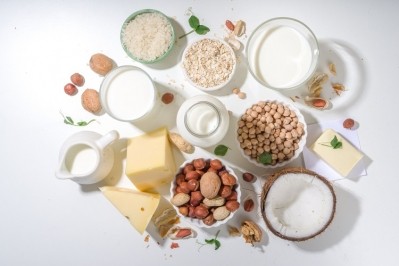How cultivated and plant-based technologies can unlock the next wave of innovation in the protein transition

The plant-based meat market is already a sizeable category. Data from the Good Food Institute (GFI) shows it has grown from worldwide sales of US$430m in 2019 to a value of $1.4bn globally in 2020. But there is still plenty of runway for future expansion. Plant-based analogues account for just 1.4% of total retail meat sales and have a household penetration of 18%, GFI revealed.
Many believe that key to unlocking this potential is to create products that deliver an experience closer to meat. Next generation development efforts are increasingly focused on delivering whole cuts like chicken breasts or beef steaks.
Whole cuts are the ‘holy grail’ of plant-based NPD
One such innovator is Juicy Marbles, which produces a soy-based fillet mignon using its unique ‘Meat-o-matic’ technology to 'assemble' lean meat and fat components. For CEO and founder Tilen Travnik, the alt protein push towards whole cuts is hardly surprising. Whole cuts, after all, represent around 60% of ‘real’ meat consumption. “It is natural that quite a few companies are chasing that dream of either a plant-based or cultured whole cut. Whatever the technology is behind it, whole cuts are the holy grail right now,” he said.
Speaking at the FoodNavigator Protein Vision event earlier this year, Travnik explained that he expects the quest for whole cuts to accelerate technological innovation in plant-based production. “Whole cuts as a concept will allow us to develop the technology around aromas, structure and mouthfeel of the individual sub-components that make up a whole cut, leveraging the experience that those separate components can provide,” he predicted.
Juicy Marbles, for instance, is today is able to produce a plant-based steak that has fat marbling similar to that seen in conventional steaks.
But while technological advancements have the potential to accelerate future product development, NIZO Project Manager for Plant Protein Technology Steven Cornet told us that strengthening today’s technology is in itself one of the biggest challenges facing the sector. “In terms of, for example, extrusion technology, the thickness of the product is quite limited, and the fabulousness is not always comparable to real steak,” he noted.
Approaches like sheer-shell technology, which transforms vegetable protein into a layered, fibrous structure that closely matches the appearance and texture of steak, have their own issues, the plant protein expert continued. “Sheer shell technology is not as scalable as extrusion, but the product quality can be better if you get the formulation right. The challenge here is scalability. It is a batch-based technology at the moment, to bring that to industrial scale is quite challenging.”
Clean label conundrum
This isn’t the only hurdle plant-based formulators face as they work to create an ever more ‘meaty’ bite. They also need to take into consideration consumer expectations for clean labels.
Take methylcellulose for example. Used by high-profile brands like Impossible Foods and Beyond Meat, it provides attractive gelling and emulsifying properties that hold plant-based burgers together as they cook and boost juiciness. However, as current litigation making its way through the US courts highlights, methylcellulose isn’t something that consumers have in their kitchen cupboards and is often held up as evidence of the ‘ultra-processed’ nature of plant-based meat analogues.
Focusing in on this ingredient, both Cornet and Travnik stress that it is one that is commonly used in processed meat and other food industry applications. Nevertheless, whether deserved or not, methylcellulose has become associated with questions around plant-based meat’s ability to deliver clean label products.
“It is one of the main challenges that many product developers are facing. How do we replace this magic ingredient? Because it does have many properties that are sought after. It can form a gel; it can emulsify; it can bind a lot of water. To replace all that functionality, you probably need a whole list of ingredients and this is something consumers frown on,” Cornet noted.
Ido Savir is CEO of Israeli cultured meat pioneer SuperMeat. He agrees that a drive towards clean label will become evident in future innovation efforts in the alternative protein space. “I believe we are going to see more emphasis on having ingredient lists as clean and high quality as possible,” he predicted. “We are in the first or second generation of these high-quality meat analogues. The early generations were not the best, we had to compromise on some things. Now we are putting more emphasis on making it both clean label and high quality.”

Hybrid products: The best of both?
Savir believes that cultured meat – made from base animal cells and grown in bioreactors – could play an interesting role in this space, offering functional ingredients that he described as ‘clean in their essence’.
Slaughter-free but animal derived, Savir believes a hybrid approach incorporating both cultured meat and plant-based can offer the ‘best of both worlds’. In this scenario, ‘enhanced plant-based products’ would leverage cell cultured ingredients such as fat, which are important for flavour delivery and mouthfeel. “Providing highly functional ingredients from a cultured source can help reduce the ingredient list but still provide a superior experience for the consumer.”
But would this approach resonate with consumers? Savir highlighted consumer research undertaken by SuperMeat that suggests around half of consumers are already willing to give cultivated meat a whirl. And - with the majority of people who shop plant-based reporting they are motivated by either health, environmental or animal welfare concerns - Travnik said he absolutely sees hybrid products that incorporate cultivated ingredients meeting these needs. “There is a big distinction between the hybrid products we have today and the hybrid products that will come into the market [that use cultivated ingredients] and that is the ethical element,” he suggested.
“There are certain things the cellular agriculture community can provide for the plant-based community. Think aromas and fats.”

Scale and market reach for cell-ag
Collaboration with the plant-based sector could also help cellular agriculture overcome what Savir characterises as one of this emergent industry’s greatest barriers: scale.
The food tech entrepreneur believes that cultivated meat is on the precipice of reaching market. While regulatory approval is still pending globally – with the exception of Singapore – he predicts that the first generation of cultured meat products will start to become commercially available next year. The big issue, he continued, is ‘cost and capacity’.
Hybrid products offer the opportunity to build scale and mass reach hand-in-hand. “Most companies with a mass product will come through hybrid products for two reasons,” Savir forecast. “First cost and capacity, because we are limited in both. Second, product maturity. We still have work to be done. Using these hybrid approaches allows us to leverage the incredible technology that’s already available in the food industry.”
For its part, Travnik revealed Juicy Marbles is already collaborating with unnamed partners in the cellular agriculture space to trial different components, using Juicy Marbles production technology as a ‘test bed’ for cultivated ingredients. “Hybrid products are coming, and I think they are coming soon,” he predicted.
































